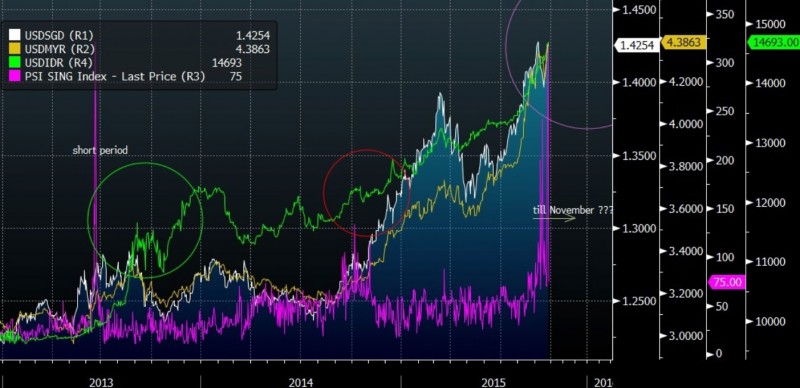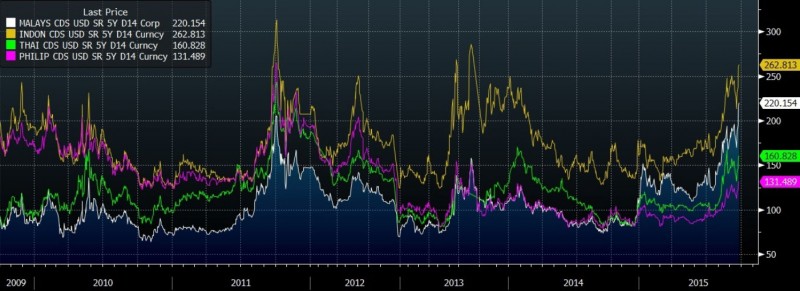Hazing The Tri-Nations: Worst Performers of Asia
My best friend flew off to Sandakan, Sabah, yesterday and transited in Changi because SIA promotes the Singapore transit point with generous $20 shopping vouchers for travellers. Thinking that she did not know that she was about to fly into the heart of the haze, I rushed to the airport with the necessary N95 face masks and now she tells me from Sandakan that it is all clear skies there mainly because the wind does not carry the haze west but rather, south-west which is why it is coming to us and Malaysia.
Singapore and Malaysia are undeservedly paying the annual price for the Borneo (and Sumatran) fires although we should be glad we do not live in Kalimantan where PSI readings are going at 2,000 and the innocent citizens are suffering watching their PSI climb with the USDIDR as the USDSGD and USDMYR follow suit.
Indonesia is literally hazing us, although not in the same context as the textbook definitions.
Here I have plotted the Singapore PSI readings (which is the only one with history available although it is the NEA one which could be understated at times) against the currencies.
To the naked eye, PSI spikes are not good for the currencies which could be coincidences, I suppose.
Singapore was a part of Malaysia just 50 years ago and the association remains quite intact for the 2 countries linked by 2 causeways, both second largest trading partner to each other after China. Throw in Indonesia which counts Singapore as their second largest trading partner (Indonesia ranks as Singapore’s fourth largest), and we have a solid geographic and economic trinity of states.
Malaysia’s Problems
As it is, Singapore’s markets have not had a good year and some fingers are pointing at Malaysia accusingly. Malaysia joins the list of blame that ranges from the monetary policy to currency wars to the poor economic growth, regional slowdown, oil prices and of course, China.
The Malaysian problem is probably the hardest to quantify. What is wrong with Malaysia?
It is not the economy as we have said 6 months ago: Economics Does Not Work In A Sentiment War
And it is not just Malaysia aversion now when we have the entire EM at stake and hanging on the whim of China’s economic fortunes which, hopefully, will turn once they revise their GDP computation methods just like how India got away with in Jan this year (jumping from 5% to 7.5%) and has since become the economic darling of global investors.
In other words, the Malaysian situation is exacerbated by the EM problem and to say that Malaysia is in dire straits is perhaps understating it because there is no way of knowing how far the capitulation will go, just like no one would have foreseen the USDMYR at 4.4045 on Thursday, that has not been seen since 1998, along with the Brazilian Real making history against the USD at 4.2478 before gaining a record breaking 7% gain within the same day to 3.97. Likewise, the Turkish lira made history this week, so we cannot really fault Malaysia except that it is exceptional in the context of Asia, the former economic darlings of the global investment world who have always preferred EM Asia to EM Latam.
This is the biggest quarterly gain we have seen for the USDMYR since 1997, noting that the currency strengthened back after making its historic high of 4.885 back in 1Q98. The rupiah has not performed as poorly even though we are also back to 1998 levels.
Tensions are running high again because since March, a lot more has happened to the extent that the FBI is involved in the 1MDB investigations which really cannot really amount to much after the fire at the Malaysian police headquarters earlier in July ? Besides the attorney general and his deputy have been replaced, the deputy prime minister replaced, among others. Racial politics being played right now with the warning that “Malays and Muslims would be destitute if Umno loses its power in ruling the country.”
The cost is piling up and investors are buying insurance against A3/A- rated Malaysia, driving its credit default swap volumes along with the credit spread which is at a 6 year high, closing in on Baa3/BB+ rated Indonesia and towering above lower rated Thailand and Philippines.
The Haze Nations Have It Worst In Asia
Taking out the scorecard for the year so far, the 3 countries have it bad.
Indonesia -19.47% on stocks and -15% on its currency.
Malaysia -8.3% on stocks and -20.37% on its currency.
Singapore -15.82% on stocks and -6.97% on its currency.
No other country in Asia comes close to such losses and this comes against not so bad GDP numbers from the 3 of them.
Singapore suffers the double whammy of higher interest rates which we wrote about last week but Malaysia lost over a quarter of its foreign reserves in just 12 months.
The Bright Spots of The Haze
Going forward, “The Haze Effect” would be a good “cloud cover” (excuse the pun) for economic performance if the markets would give them a chance. It is likely more likely that economic forecasts will be lowered which gives the economies a chance to “outperform” on the lower estimates even though productivity has been affected.
This year’s haze is predicted to be prolonged till November!
It would also mean that Malaysians would think twice about organising any street demonstration to disrupt the peace given the health hazard warnings and it could well be the reason why a widely expected rally in KL did not transpire this weekend, as expected.
“The Haze Effect” will also occupy media space, taking people’s minds off their stock losses and continue spending on medications and filters as they are kept indoors or within the confines of shopping centres.
“The Haze Effect” is probably positive on community spirit, giving citizens a common problem and opportunities to help each other.
My Thoughts
Once the haze clears, Malaysia could be in the spotlight again for it is clear that politics is being fought from a very tight corner with no escape for the A- rated nation until a grand finale of sorts now that we have a global audience. Indonesia will be out of the woods (and hopefully, out of wood to burn for next year) as El Nino is expected to drive up soft commodity prices although many companies now boycotting Indonesia for palm oil. Singapore would be caught in between the two and hopefully not dragged further into the Malaysian scandal, being a part of the money trail.
The long term case for Indonesia remains intact with their population rapidly ascending to middle class and they start using their natural resources on themselves like they are doing for minerals and ores. The Asian formula has always been one of population wealth growth through real estate and Indonesian developers are still building away despite the crisis and against Fitch rating agency’s warning. I would still favour retail companies while waiting for the big crash in property like what happened to China several times in the past 15 years.
It is a pity that the air levels are too unhealthy for Singaporeans to travel to Malaysia to shop given that SGDMYR made a new historical high of 3.09 on Thursday, giving Malaysians working in Singapore a 17% pay hike for 2015 and it is hard to see an end in sight (to their windfall) and each day, the risks of a downgrade increases until perhaps if the FBI declares that 1MDB is innocent or if the Malaysian prime minister opts to secede.
Till then, Singapore can continue to blame Malaysia for her torrid markets and curse Indonesia for the haze. Excuse me, I think I have developed a sore throat.





